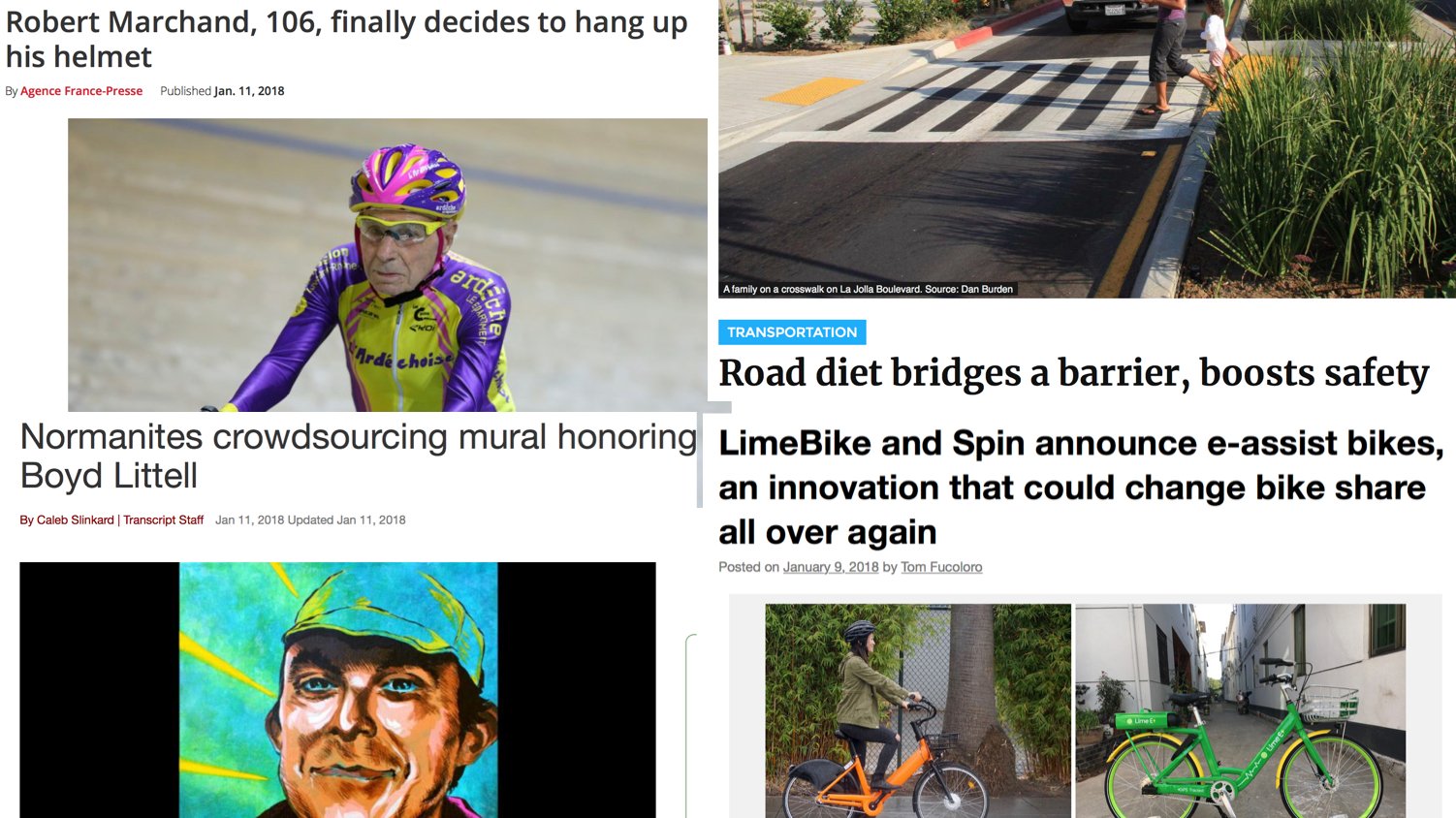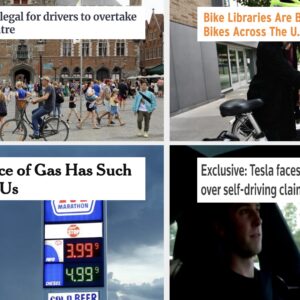
Yes I realize it’s Tuesday. It just didn’t feel right to post this on Martin Luther King Day (I posted something about activism instead, thinking that was more in line with the spirit of the holiday).
So without further ado, here are the best stories we came across last week…
The future is B2V: Bikehugger was at the big Consumer Electronics Show (CES) and got the scoop about a partnership between Ford, Tome, and Trek that will hasten development of “bicycle-to-vehicle” or B2V communication.
Dockless diversity: A Citylab reporter in Washington D.C. has a strong hunch that people of color use dockless bike share bikes more often than other types of bikes.
Dockless gets a boost in Seattle: Spin and LimeBike will soon roll out e-assist versions of their bikes in the Seattle market.
San Fran too: In related news, Ford has partnered with e-bike giant GenZe to electrify the GoBike fleet in San Francisco.
Advocacy tool for your mayor: TransitCenter has created a handy, 2-page PDF to help activists deal with mayors who are strong on climate change but weak on reducing car use and improving transit.
Great biking, great driving: The traffic-avoidance and route experts at Waze came out with a Driver Satisfaction Index and guess which country has the happiest drivers? The Netherlands.
Advertisement
A mural for Boyd: Boyd Littell was a Portland-based musician and bicycle messenger who died mysteriously while cycling near Colonel Summers Park back in October. His hometown of Norman, Oklahoma has raised money to create a mural in his memory.
Bike tourism = $$$: A tiny town in Montana that has just 50 residents gets about 1,000 tourists a year who pass through on one of several cross-country bike routes. That’s the kind of economic impact small towns in rural Oregon might start to see as the award-winning Oregon Timber Trail becomes more well-known.
Streets for people: A road diet in the coastal town of La Jolla, California reduced crashes by 90 percent. Check the amazing before/after images in this case study published by the Congress for New Urbanism.
Ferries to the rescue: With the only highway in Santa Barbara blocked due to a mudslide, road users turned to an ad-hoc ocean ferry service to get where they needed to go.
106-year-old rider calls it quits: Frenchman Robert Marchand rode his bike until the age of 106 and now figures it’s time to hang up the helmet.
Thanks to everyone who submitted links!
— Jonathan Maus: (503) 706-8804, @jonathan_maus on Twitter and jonathan@bikeportland.org
Never miss a story. Sign-up for the daily BP Headlines email.
BikePortland needs your support.






Thanks for reading.
BikePortland has served this community with independent community journalism since 2005. We rely on subscriptions from readers like you to survive. Your financial support is vital in keeping this valuable resource alive and well.
Please subscribe today to strengthen and expand our work.
Chapeau Mssr. Marchand!
B2V – I thought bicycles were considered vehicles.
Depends on the state. In California bicycles are not vehicles under the vehicle code. Devices that are solely human powered or designed to travel only on rails are not vehicles in California.
“A bicycle is a device upon which any person may ride, propelled exclusively by human power through a belt, chain, or gears, and having one or more wheels.”
Aha.
Which suggests that B2V cannot be used to describe an ebike… Hm.
Actually e bikes are bicycles under the Calif law.
312.5. (a) An “electric bicycle” is a bicycle equipped with fully operable pedals and an electric motor of less than 750 watts.
(1) A “class 1 electric bicycle,” or “low-speed pedal-assisted electric bicycle,” is a bicycle equipped with a motor that provides assistance only when the rider is pedaling, and that ceases to provide assistance when the bicycle reaches the speed of 20 miles per hour.
(2) A “class 2 electric bicycle,” or “low-speed throttle-assisted electric bicycle,” is a bicycle equipped with a motor that may be used exclusively to propel the bicycle, and that is not capable of providing assistance when the bicycle reaches the speed of 20 miles per hour.
(3) A “class 3 electric bicycle,” or “speed pedal-assisted electric bicycle,” is a bicycle equipped with a motor that provides assistance only when the rider is pedaling, and that ceases to provide assistance when the bicycle reaches the speed of 28 miles per hour, and equipped with a speedometer.
Unicycles and tricycles are defined as bicycles: someone slept through Latin.
Orwellian.
…not if they are “direct drive” with cranks attached to a wheel hub—no “belt, chain, or gears”. So a penny-farthing would also not be a “bicycle” according to that definition.
It is rather humorous when people who have zero experience riding (or even looking at, apparently) bicycles make laws pertaining to bicycles. Do they even consult for this stuff? Or is the assumption that human-powered conveyances (“bicycles”) and their operation are so simple that anyone in a law-making capacity must know all there is to know already?
Of course they looked at it! Back around 1955 when they wrote it…
There are advantages to having bicycles not defined as a vehicle. Like when riding up in the mountains and there are signs posted prohibiting vehicles past a certain point you can ignore those signs if you are on a bike since a bicycle isn’t a vehicle.
“La Jolla, California reduced crashes by 90 percent.”
Curious what the local vision zero grumpies will have to say about that.
Traffic deaths only happen to other people, not good drivers like themselves. You know, the ones who speed through our neighborhoods while complaining about enforcement.
Here they bullied the city council out of a road diet, despite police fully behind it and showing significant reductions in rear-end crashes and speeding tickets (at the section where it was implemented). They screamed that their drive time delays were significant (despite traffic timing studies disproving), and that nobody ever saw any bicyclists so the road didn’t need bike lanes. Ironically, the design goal of going from four lanes to three with a middle turn lane was to solve the biggest problem: locals getting rear-ended while waiting to turn into their driveways. The (door zone) bike lanes were just to take advantage of the spare width.
They are now screaming that “something needs to be done” about the one section already implemented – in reality, local cyclists avoid it because traffic to the new Apple campus (and associated retail malls) has made it ridiculously dangerous. (I was recently rear-ended while driving at the speed limit there – guy said I was “going stupidly slow” so what did I expect…).
Speaking of ferries, there has been a proposal to start an Olympia-to-Seattle passenger only ferry to help relieve I-5 traffic. This may well happen in the next couple of years. For a, literal, dream boat, a Ridgefield-St. Helens ferry idea was floated a few years ago–wonder what happened to that?
An Olympia-Seattle ferry is an objectively terrible idea. Ferries are too slow and fuel-inefficient to be practical alternatives to ground transportation unless the over-land route is several times longer. Unfortunately money to study impractical nonsense is in greater supply in the northwest than courage to approach real solutions (like reserving a well-managed HOV/transit lane on the most congested parts of I-5, creating a real incentive for more efficient road use).
I will be interested to see how the dockless bikeshare systems like SpinBike can manage an e-bike fleet.
How will they be recharged, since the bikes get left all over and where-ever? Sending employees out to locate and swap batteries for 500 ebikes every day sounds impossibly expensive.
Why won’t these ebikes be stolen right and left, since an e-bike is a valuable object? It will be easy to disable the internal lock and GPS tracking, rattlecan the bike, and have one’s own personal ebike for $0, or harvest the components.
Good questions. I will be in Seattle this weekend, and of course I’ll be checking out both LimeBike and Spin. e-LimeBikes are supposed to be rolling out this week, so if I see one I’ll snag it for a ride and report back here.
I just spent a day and a half all over central Seattle. If Lime did roll out any actual e-bikes this week, I didn’t see them. I checked their app too, which uses different icons for pay bikes vs a handful of free bikes; presumably e-bikes would have a different icon, but I didn’t see any.
But I will tell you this: after a weekend of riding dockless sharebikes nearly 50 miles all over Seattle, dockless is revolutionary. Consider the game changed. Dock-based bikeshare is nice for the small ride zones these systems have defined, but dockless expands the concept exponentially. Now you can ride anywhere in the city you want (or apparently, even outside the city – the app is also showing a handful of bikes across the lake in Bellevue and as far south as Federal Way). Just lock up anywhere you want, as long as it’s not blocking the sidewalk.
The process is massively simpler than traditional bikeshare: just download the app, enter credit card info and scan the QR code on any bike to unlock. Cheaper than traditional bikeshare, too: the going rate is $1 per hour or half-hour, depending on the system. Some of the systems also have an app-free rental method, from what I understand. So I can see why nontraditional bike users might be using these systems in greater numbers. The barriers are lower.
Another big change is the sheer number of bikes. They are EVERYWHERE. At a lot of streetcorners you’ll see half a dozen or more. Sometimes all the same brand, sometimes all 3 (Ofo is the third major player in Seattle, along with LimeBike and Spin).
Of the three, LimeBike is by far the premier system. The bikes are quite a bit nicer, seem a little beefier than the other two offerings, and seem to be in a much better state of repair. LimeBikes have 8 speeds instead of Ofo’s and Spin’s fairly tall-geared 3-speeds, which are really a struggle on Seattle’s hills; by contrast, I rode a LimeBike in first gear up Spring Street, which I believe is something like a 15% grade, without too much difficulty.
The bikes aren’t as solid as BikeTown bikes, but they are also lighter and still have front cargo racks. Lime and Ofo have drum brakes, and seemingly more powerful ones than in BikeTown (or MN’s Nice Ride) bikes. Spin bikes have V-brakes, which made a lot of noise in the rain and on at least one bike were scarily ineffective.
Which brings me to the biggest challenge these systems face: keeping the bikes in good repair. Ofo – which I might as well put an “m” in front of at this point – was by a wide margin the worst. Nearly half the bikes I tried to unlock wouldn’t unlock due to either an error message (which, in fairness, happened a couple times with Lime too) or the app telling me the bike was out of service. Worse, more than half the bikes I successfully rented had big problems: drivetrain stuck in one gear, seatposts that wouldn’t adjust, handlebars askew. In several instances I rode the bike a few blocks until I found a different one to rent instead. That said, usually after a couple tries I did find a usable ofo bike to ride.
Spin’s bikes were in somewhat better repair, though they had some no-shift and stuck-seatpost problems too. Worse though, in order to report a problem you have to do an online chat, which isn’t available evenings and weekends. WIth the other two systems you can report the problem with a couple clicks of the app.
Lime’s bikes were much better, and I ended up using their system more, especially later in the weekend as I got tired of dealing with the other systems’ problems. They weren’t perfect, either – two bikes had loose seatpost binder bolts – but far better than the others.
I can now understand the problems Chinese cities are facing with broken bikes all over the place. Seattle doesn’t have this problem – YET. RIght now Seattle has mostly-functioning bikes all over the place. But if Ofo and Spin don’t stay on top of things, it’s going to get bad in a hurry.
As Portland considers dockess sharing, I would suggest they offer the vendors incentives to keep their bikes in good repair. They should be paying the cities a franchise fee for use of the public right of way (for bike parking), and while it shouldn’t be onerous there ought to be charges for nonfunctioning bikes clogging up the works. I’ll be checking into the Twin Cities’ plans for this too, as our venerable Nice Ride system just announced last week that they’ll be switching to dockless in 2020 as well.
Thanks for that report GlowBoy! I’ve been wanting to get up to Seattle myself. Appreciate you sharing this as we get closer to dockless here in Portland.
Sure! I would highly recommend getting up there to check out the revolution in progress. Seattle’s only 3-4 hours away by car, train or bus (I took BoltBus, FWIW, for about $20 each way).
I think this massively democratizes not only bikeshare, but bicycling itself. Although I’ve been impressed seeing so many sharebikes on the streets of Portland and Minneapolis since their dock-based systems came online, they are nothing compared to what is going on in Seattle. You see people out riding these bikes everywhere, and at all hours. I’m sure a lot of the users are people who wouldn’t ride bikes much otherwise. One side benefit is that it makes drivers radically more accustomed to seeing bikes on the streets.
By the way, here’s a link to the article talking about the Twin Cities’ forthcoming switch to dockless (sorry, got the timeline wrong – it will be 2021, not 2020). Interestingly, they have chosen Motivate as the vendor, even though Motivate is not one of the major dockless vendors currently. Also, the article is about how even though the current system works across both Minneapolis and St. Paul, for some reason the initial negotiation covered Minneapolis only. Personally, I’m not worried about this: St. Paul (and Minneapolis) just elected more progressive new leadership in November, so I’m sure they’ll iron that out by 2021:
http://www.startribune.com/questions-arise-over-how-a-new-bike-sharing-system-will-work-in-the-cities/470186653/
If you combine the results of the road diet in San Diego with the PDF on dealing with cars and climate change, it makes local politicians and staffers that are unwilling to give up on old time auto-centric infrastructure look like irrational dinosaurs.
B2V? Sounds like more nonsense the concern trolls can ask about. “Was he wearing his helmet?”, 2025 edition. “We’re not victims,” says Trek — if the driver’s insurance lawyers, or even the police that should be protecting us, can think of one gizmo we didn’t have on us, well then surely we can share the fault for getting clobbered by an inattentive driver.
What are these “potentially dangerous roadway areas” where drivers need extra help seeing cyclists? Blind curves? With all the additional sensors and cameras on cars these days, it shouldn’t be difficult for more and more cars to alert their drivers if they’re going faster than their forward visibility should allow. Oncoming lefts and right-hooks? Again, anyone in immediate danger from the driver should be detectable without any special gear on the bike.
It could have been a thing of beauty, but the emphasis on pedestrians and cars with bikes tossed to the back of the bus ruins it. Door zone bike lanes? Seriously? The options were to either use enough space to keep the bike lane clear of the door zone, which would have created a perception of a longer distance to cross for pedestrians, or to eliminate the bike lanes altogether and just put down sharrow markings and “bikes may use full lane” signage. It is a 15 mph street, afterall, so it’s not like that would be tossing people on bikes into the shark tank.
As it is, they settled for a perception of safety for cyclists that is in reality a trap. Sure, there are so few people on bikes in La Jolla that putting them at risk won’t show up in any measurements, but putting in door zone bike lanes is a great way to keep the number of people on bikes at a low level.
I’m responding to this in general later – but the road diet was put in before Complete Streets were considered in San Diego, so hence the lack of bike lanes on La Jolla Blvd itself. Also, only the roundabouts have an advisory speed limit of 15mph; the road itself is either posted 25 or 30mph (which was a reduction from 35 IIRC).
Agree, funny enough I drove this section of road and it’s five traffic circles this fall. Seemed like a great improvement in that I felt required to drive slowly and that vehicle throughput was not a priority. However, I did instantly notice to squandered opportunity to put in some off street bike lanes and ANY bike specific space at the traffic circles. It’s still painfully obvious you are in California. However… I would have no problem taking the lanes along this section of road, which I can’t say for many places in the San Diego area.
Really wish we would move from median space between car lanes to median space between vehicles and bikes/sidewalks.
Bird Rock also as parallel greenway type facilities.
Yes, medians in the middle that separate cars going opposite directions make some sense on high-speed freeways (for safety), and on streets where the median width also becomes a left-turn lane. But neither are the case for La Jolla, so it does seem it could have made more sense to use that 8′ or so of street width differently–either to separate cars from bikes and sidewalks like you said, or maybe wider sidewalks and/or bike lanes.
Here’s a Google Maps link to the area where the La Jolla Blvd road diet was implemented – https://goo.gl/maps/bYqghVMDMpt
I’m familiar with the area as I cycle through there on occasion and my car mechanic’s shop is in one of the photos.
La Jolla Blvd is the main arterial between the major beaches and La Jolla, but most people will use Interstate 5 if they need to get anywhere outside of either place. It’s still an important road as there’s a lot of rush hour traffic and a few businesses, but otherwise is residential. Most traffic goes through the area north-south; east-west is severely limited by the Pacific Ocean and Mt. Soledad.
Originally it was a 4-5 line major road with a 35mph speed limit. Residents of Bird Rock wanted something for pedestrians and kids to safely cross as it was unsafe; an elementary school is on the next street over. The road diet reduced the speed limit to 25 or 30mph and put in roundabouts that have a rather tight turning radius. From Google Maps you can tell that the bike infrastructure is minimal; it was largely designed before Complete Streets was implemented.
The design is excellent for pedestrians and cars, but LJ Blvd itself is not particularly bike-friendly and I don’t personally consider the road diet an improvement from that perspective. Fortunately there are two excellent Class III bike routes on the streets either side of it to facilitate through-biking, and very few people would want to bike up the grades when walking is supported for the neighborhood.
Actually, according to reports M. Marchand is only giving up competitive cycling, and has decided at age 106 to curtail his riding “only” to leisurely efforts! To be so lucky. Doublement chapeaux!
Picking nits: “further ado”, not “further adieu”.
Thanks dan. I’ll fix that.
Yes, you’d only use “further adieu” in a situation like, “Fearing the prolonged goodbyes would cause him to miss his train to Marseille, Monsieur Dupont left the party without further adieu”.